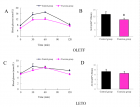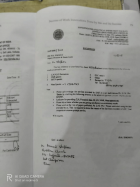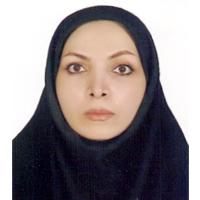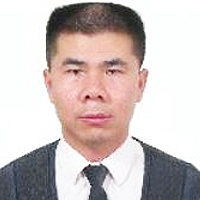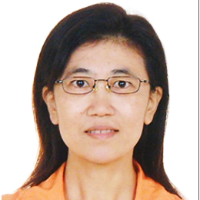Abstract
Research Article
Application of Nonlinear Dynamic Models of the Oculo-Motor System in Diagnostic Studies in Neurosciences
Vitaliy D Pavlenko*, Tetiana V Shamanina and Vladyslav V Chori
Published: 30 October, 2023 | Volume 7 - Issue 2 | Pages: 126-133
The purpose of this work is to implement methods and develop tools for nonlinear dynamic identification of the Oculomotor System (OMS) “input-output” in the form of Multidimensional Transient Functions (MTF) based on eye tracking data and their use in an information system for diagnosing the psychophysiological state of a person. The object of the study is the process of diagnosing the psychophysiological state of an individual based on innovative eye-tracking technology. The subject of the research is computational algorithms and software for determining diagnostic features based on identification data of compulsory medical insurance in the form of MTF, constructing a Bayesian classifier using machine learning in the established space of the most informative features. A methodology has been developed and implemented for the experimental study of human compulsory mental health using innovative eye-tracking technology to record compulsory mental health responses to test visual stimuli. The obtained empirical data from input-output studies are used for the identification of OMS based on Volterra polynomials. Experimental studies of compulsory medical insurance of respondents were carried out before and after the working day. Based on the data obtained using the Tobii Pro TX300 eye tracker, the transient functions of the first, second, and third orders of the OMS were determined. Variability of second and third order transient functions was revealed for different psychophysiological states of the respondent (normal or fatigue). Thus, it seems appropriate to use MTF in diagnostic studies in the fields of neuroscience and psychology. Information technology for diagnosing human psychophysiological conditions has been further developed through the use of compulsory health insurance information models based on Volterra polynomials as a source of primary data. This allows for an increase in the accuracy of OMS modeling and, consequently, enhances the reliability of diagnosis within the framework of the proposed heuristic features. A set of heuristic features is proposed, which are determined using integral and differential transformations of the MTF OMS. The information content of individual features and all possible combinations of them in pairs was studied using the Probability of Correct Recognition (PCR) indicator. Two-dimensional feature spaces with the maximum PCR value (0.938) were identified during the diagnosis of a person’s psychophysiological state.
Read Full Article HTML DOI: 10.29328/journal.jnnd.1001086 Cite this Article Read Full Article PDF
Keywords:
Psychophysiological states; Oculomotor system; Eye-tracking technology; Nonlinear dynamic identification; Volterra model; Multidimensional transient functions
References
- Corveleyn X, Justine B, Ott L, Lavenu I, Delayen C, Di Pastena A, Coello Y. Body-centred and Object-centred Motor Imagery in Alzheimer's Disease. Curr Alzheimer Res. 2018;15(3):247-258. doi: 10.2174/1567205014666171030105720. PMID: 29086694.
- El Haj M,Coello Y, Kapogiannis D, Gallouj K, Antoine "Antoine. Negative Prospective Memory in Alzheimer’s Disease: «Do Not Perform That Action»." Journal of Alzheimer's Disease. 2017; 61.2: 663-672.
- Rigas I, Komogortsev O, Shadmehr R. "Biometric Recognition via the Complex Eye Movement Behavior and the Incorporation of Saccadic Vigor and Acceleration Cues. " ACM Transactions on Applied Perception. 2016;2: 1-21.
- Lanata A, Sebastiani L, Di Gruttola F, Di Modica S, Scilingo EP, Greco A. Nonlinear Analysis of Eye-Tracking Information for Motor Imagery Assessments. Front Neurosci. 2020 Jan 15; 13:1431. doi: 10.3389/fnins.2019.01431. PMID: 32009892; PMCID: PMC6974582.
- Jansson D, Medvedev A, Axelson H, Nyholm D. Stochastic Anomaly Detection in Eye-Tracking Data for Quantification of Motor Symptoms in Parkinson’s Disease, Signal and Image Analysis for Biomedical and Life Sciences, Springer International Publishing, Cham. 2014:63-
- Jansson D, Rosen O, Medvedev "Parametric and Nonparametric Analysis of Eye-Tracking Data by Anomaly Detection. " IEEE Transactions on Control Systems Technology. 2015; 23.4: 2015:1578-1586.
- Bro V, Medvedev "Nonlinear dynamics of the human smooth pursuit system in health and disease: Model structure and parameter estimation." IEEE 56th Annual Conference on Decision and Control (CDC). 2017;4692-4697.
- Pavlenko V, Salata D, Dombrovskyi M, Maksymenko Yu. "Estimation of the Multidimensional Transient Functions Oculo-Motor System of Human." Mathematical Methods and Computational Techniques in Science and Engineering. 2017; 110-117.
- Pavlenko V, Salata D, Maksymenko "Nonlinear Dynamic Model of an Oculo-Motor System Human based on Volterra Kernels." WSEAS Transactions on Systems. 2017; 234-241.
- Pavlenko VD, Salata DV, Chaikovskyi "Identification of an Oculo-Motor System Human Based on Volterra Kernels." International Journal of Biology and Biomedical Engineering. 2017;11: 121-126.
- Pavlenko V, Ivanov I, Kravchenko E. "Estimation of the Multidimensional Dynamical Characteristic Eye-Motor System." Proceedings of the 9th IEEE International Conference on Intelligent Data Acquisition and Advanced Computing Systems: Technology and Applications (IDAACS). 2017; 2: 645-650.
- Pavlenko VD, Fomin OO, Fedorova AN, Dombrovskyi "Identification of Human Eye-Motor System Base on Volterra Model." Herald of the National Technical University "KhPI". A series of "Information and Modeling".2016; 21:1193; 74-85.
- Pavlenko V, Pavlenko "Deterministic Identification Methods for Nonlinear Dynamical Systems based on the Volterra Model." Applied Aspects оf Information Technology. 2018; 01.01: 9-29.
- Apartsyn AS, Solodusha SV, Spiryaev VA. "Modeling of Nonlinear Dynamic Systems with Volterra Polynomials." International Journal of Energy Optimization and Engineering. 2013; 4:16-43.
- Doyle FJ, Pearson RK, Ogunnaike BA. Identification and Control Using Volterra Models (Communications and Control Engineering), Springer London. 2001;
- Pavlenko VD, Milosz M, Dzienkowski "Identification of the oculo-motor system based on the Volterra model using eye tracking technology." Journal of Physics: Conference Series. 2020; 1603: 012011.
- Tikhonov AN, Goncharsky AV, Stepanov VV, Yagola AG. Numerical Methods for the Solution of Ill-Posed Problems. Netherlands: Springer. 2013.
- Pavlenko V, Shamanina T,Chori "Nonlinear Dynamics Identification of the Oculo-Motor System based on Eye Tracking Data." International Journal of Circuits, Systems and Signal Processing. 2021; 15: 569-577.
- Tharwat A, Classification assessment methods, Applied Computing and Informatics. 2020; 1-13.
- Medvedew A, Fomin O, Pavlenko V, Speranskyy V. Diagnostic features space construction using Volterra kernels wavelet transforms, in: 9th IEEE International Conference on Intelligent Data Acquisition and Advanced Computing Systems: Technology and Applications (IDAACS), Bucharest, Romania. 2017; 2: 1077–1081. DOI: 10.1109/IDAACS.2017.8095251
- Vapnik VN. The Nature of Statistical Learning Theory. Springer Verlag New York Inc. 2010.
- Vapnik "Complete Statistical Theory of Learning, Automation and Remote Control." 2019; 80:11; 1949-1975.
Figures:
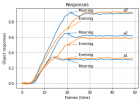
Figure 1

Figure 2
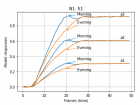
Figure 3
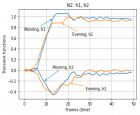
Figure 4
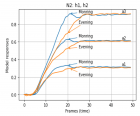
Figure 5
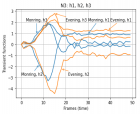
Figure 6
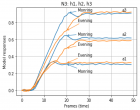
Figure 7

Figure 8

Figure 9
Similar Articles
-
Application of Nonlinear Dynamic Models of the Oculo-Motor System in Diagnostic Studies in NeurosciencesVitaliy D Pavlenko*, Tetiana V Shamanina, Vladyslav V Chori. Application of Nonlinear Dynamic Models of the Oculo-Motor System in Diagnostic Studies in Neurosciences. . 2023 doi: 10.29328/journal.jnnd.1001086; 7: 126-133
Recently Viewed
-
Prediction of neonatal and maternal index based on development and population indicators: a global ecological studySedigheh Abdollahpour,Hamid Heidarian Miri,Talat Khadivzadeh*. Prediction of neonatal and maternal index based on development and population indicators: a global ecological study. Clin J Obstet Gynecol. 2021: doi: 10.29328/journal.cjog.1001096; 4: 101-105
-
A Genetic study in assisted reproduction and the risk of congenital anomaliesKaparelioti Chrysoula,Koniari Eleni*,Efthymiou Vasiliki,Loutradis Dimitrios,Chrousos George,Fryssira Eleni. A Genetic study in assisted reproduction and the risk of congenital anomalies. Clin J Obstet Gynecol. 2021: doi: 10.29328/journal.cjog.1001095; 4: 096-100
-
Leiomyosarcoma in pregnancy: Incidental finding during routine caesarean sectionToon Wen Tang*,Phoon Wai Leng Jessie. Leiomyosarcoma in pregnancy: Incidental finding during routine caesarean section. Clin J Obstet Gynecol. 2021: doi: 10.29328/journal.cjog.1001094; 4: 092-095
-
Adult Neurogenesis: A Review of Current Perspectives and Implications for Neuroscience ResearchAlex, Gideon S*,Olanrewaju Oluwaseun Oke,Joy Wilberforce Ekokojde,Tolulope Judah Gbayisomore,Martina C. Anene-Ogbe,Farounbi Glory,Joshua Ayodele Yusuf. Adult Neurogenesis: A Review of Current Perspectives and Implications for Neuroscience Research. J Neurosci Neurol Disord. 2024: doi: 10.29328/journal.jnnd.1001102; 8: 106-114
-
Late discover of a traumatic cardiac injury: Case reportBenlafqih C,Bouhdadi H*,Bakkali A,Rhissassi J,Sayah R,Laaroussi M. Late discover of a traumatic cardiac injury: Case report. J Cardiol Cardiovasc Med. 2019: doi: 10.29328/journal.jccm.1001048; 4: 100-102
Most Viewed
-
Evaluation of Biostimulants Based on Recovered Protein Hydrolysates from Animal By-products as Plant Growth EnhancersH Pérez-Aguilar*, M Lacruz-Asaro, F Arán-Ais. Evaluation of Biostimulants Based on Recovered Protein Hydrolysates from Animal By-products as Plant Growth Enhancers. J Plant Sci Phytopathol. 2023 doi: 10.29328/journal.jpsp.1001104; 7: 042-047
-
Sinonasal Myxoma Extending into the Orbit in a 4-Year Old: A Case PresentationJulian A Purrinos*, Ramzi Younis. Sinonasal Myxoma Extending into the Orbit in a 4-Year Old: A Case Presentation. Arch Case Rep. 2024 doi: 10.29328/journal.acr.1001099; 8: 075-077
-
Feasibility study of magnetic sensing for detecting single-neuron action potentialsDenis Tonini,Kai Wu,Renata Saha,Jian-Ping Wang*. Feasibility study of magnetic sensing for detecting single-neuron action potentials. Ann Biomed Sci Eng. 2022 doi: 10.29328/journal.abse.1001018; 6: 019-029
-
Pediatric Dysgerminoma: Unveiling a Rare Ovarian TumorFaten Limaiem*, Khalil Saffar, Ahmed Halouani. Pediatric Dysgerminoma: Unveiling a Rare Ovarian Tumor. Arch Case Rep. 2024 doi: 10.29328/journal.acr.1001087; 8: 010-013
-
Physical activity can change the physiological and psychological circumstances during COVID-19 pandemic: A narrative reviewKhashayar Maroufi*. Physical activity can change the physiological and psychological circumstances during COVID-19 pandemic: A narrative review. J Sports Med Ther. 2021 doi: 10.29328/journal.jsmt.1001051; 6: 001-007

HSPI: We're glad you're here. Please click "create a new Query" if you are a new visitor to our website and need further information from us.
If you are already a member of our network and need to keep track of any developments regarding a question you have already submitted, click "take me to my Query."






